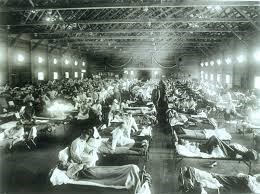
History has an unusual way of repeating itself. The whole world has been involved in a dilemma called Covid-19 for months. No one knows how much longer we will be quarantined in our homes, how many loved ones will suffer and die, or if we will ever have a vaccine to help us survive.
Recently the Dallas Morning News had a very interesting article regarding the Influenza of 1918. Reading it, I saw several similarities between 1918 and our pandemic in 2020. Let’s take a look and compare the two. First of all, we now have much more advanced medical tools, doctors and nurses, equipment and knowledge now than were available in 1918.
In the spring of 1918, not long after the United States entered the Great War that we now know as World War I. The United States had no active army; therefore, young men were sent to places like Camp Funston, a training camp attached to Fort Riley, Kansas. One of the recruits developed what was diagnosed as The Flu, sent to bed, but later died. The symptoms of chills, fever, and fatigue spread but most patients recovered rather rapidly. The recruits were sent to other training camps to prepare for the war in Europe. From September to November the second wave of the virus was far more deadly as it primarily hit cities. The medical world was overwhelmed. Does this begin to sound familiar?
Drug stores advertised numerous remedies, most based on alcohol and did little to counter the epidemic. News reports this year have noted an increase in the sale of beer and liquor.
In October 1918, 200,000 Americans died. There were no vaccines, no cures. Everyone was told to follow protective measures by wearing masks to cover faces, wash hands frequently, and avoid crowds. No spitting on sidewalks or in public. Movie theaters, churches, schools, restaurants, and other gathering places closed their doors. Women’s clubs stopped meetings. The State Fair of Texas canceled. The word was that the site was converted to a training field, but now the State Fair of Texas is closed this year. The grounds have always been a source of crowds of people during fair time. However, Dallas did decide to hold a Liberty Loan Parade that caused flu cases to increase exponentially in a few weeks.
While all of this was occurring, military personnel continued training and crossing the Atlantic to fight. The disease spread to all parts of the war. Some historians believe that the loss of soldiers on both sides, may have ended the war when it did.
One shortage in 1918 was lack of coffins, especially in cities. We saw that on television early in this pandemic. Funerals were limited to close family members and could last only fifteen minutes.
Many believed that rural areas did not suffer like city dwellers. However, the truth was that rural residents often could not afford to see a doctor, their records were terrible, and the dead were often buried at home.
One of the most poignant stories that I have heard happened here in Greenville at Burleson College. The epidemic spread like wildfire on college campuses. A young woman rooming at the girl’s dormitory did not catch the disease immediately and began caring for others. It is supposed she saved several lives before contracting the disease and dying quickly.
By the spring of 1919, the war was over and the flu, then called Spanish Influenza, stopped almost as quickly as it began. Yet, for many years, when someone had flu symptoms, they would be isolated, the whole community alerted, yet no one pursued a cure for many years. Maybe we’ll get a cure this go around.
